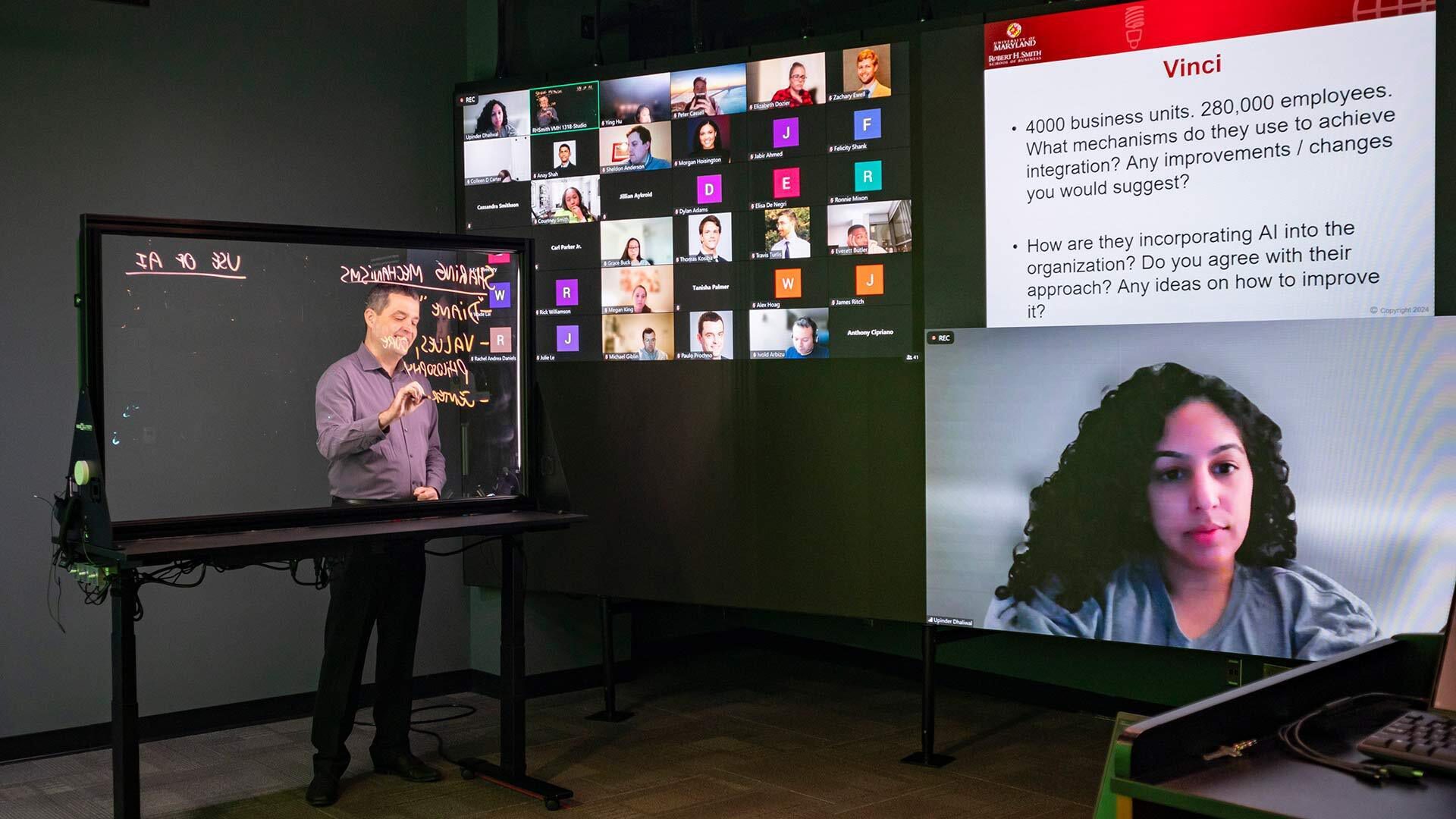- November 22, 2024
- By Ruby Siefken ’26
Paulo Prochno scribbles notes onto his classroom’s light board and steps toward the middle of the room, lifting his arms to trace a series of shapes in the air as he addresses his students on the role of AI in management.
Zachary Ewell MBA ’24 raises his hand, and his comments send Prochno back to the board.
With the click of a button, Ewell digitally drops his hand, and Prochno turns back to his students—except he’s in an empty room.
Prochno, a clinical professor in the Robert H. Smith School of Business, is the first faculty member to instruct students in the new teaching space, the first of its kind on the University of Maryland campus. It’s equipped with a 22-by-8-foot floor-to-ceiling video wall, two cameras, a lightboard and a full control room to enhance the interactive online learning experience.
The Bill Boyle Virtual Teaching Studio in Van Munching Hall opened earlier this month, named in honor of the longtime Smith School supporter and 1981 graduate who funded it with a $1 million gift.
“My hope is everyone keeps pushing for positive change. That you challenge the status quo, and break through existing barriers and roadblocks for a better tomorrow,” Boyle said in a speech during Smith’s Spring 2024 undergraduate commencement. He encouraged graduates to “create a brighter future—for all of us.”
Dean Prabhudev Konana said Boyle’s gift would help transform how the school teaches and connect with students.
“This new facility is part of our strategic plan to reimagine learning for the future,” he said. “As our working professional students increasingly prefer online learning, we need sophisticated platforms like the virtual studio to deliver an in-person experience. This new virtual studio positions us for success.”
Prochno’s course, “Leading with a Strategic Mindset,” is part of the Smith School’s flex MBA program for graduate students who work full-time. His 46 students meet via Zoom every Thursday for the seven-week course, but for the professor, the class doesn’t feel as isolated as slumping in front of his computer screen.
“With this studio format, I'm standing up, I'm moving, and instead of seeing separate slides and faces, it's one image,” said Prochno. “I have everything in a more immersive environment. So for me, it's much more like teaching an in-person class.”
Although they appear to him in the familiar grid layout, from students’ point of view, Prochno’s rectangular portion of their screen is far more dynamic than in a typical Zoom class. One camera is trained at the light board, a transparent “whiteboard” on which Prochno notes during class, and captures his face and notes through the glass wall. The other camera films Prochno in front of a green screen, which overlays his image over the notes. This allows him to interact with the information by pointing to specific diagrams of definitions while moving around the screen to increase engagement.
“The system is customizable,” Prochno said. “I can choose what I want on each screen, and we can make adjustments for every faculty member teaching in the room. It’s like a real TV studio.”
He has the grid set up with the Zoom lobby on the left and the chat box on the right. In the center of the monitor he can see what his students are seeing on Zoom, whether he’s writing notes or teaching from a slide deck.
This split screen setup helps Prochno better see student reactions, gauge participation and create a more immersive, natural teaching experience than traditional virtual classrooms.
Behind the scenes, Audio Visual Manager Antonio Cipriano oversees the class from the control room.
“I love the cutting-edge use of technology,” he said, “but also seeing it used in the way that Paulo does, which is very dynamic and interactive with the students.”
There was a trial-and-error period for faculty to become familiar with the new tech during the classroom’s first few weeks of use. Initial testing involved adjusting camera positions and solving technical issues like audio problems and connection issues. The setup is now more stable, and one goal is to use it for multiple courses next semester. Another is to appeal to students who live far away, even overseas. Some of Prochno’s students are already seeing that benefit.
“This kind of mimics an in-person experience, and because I'm out of state, it saves us time to travel and beat the traffic,” said student Ying Hu.
Topics
Campus & CommunityTags
Student Experience